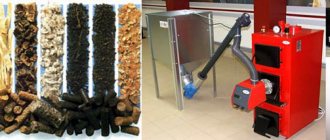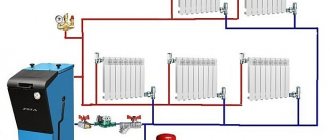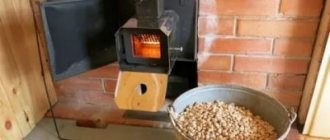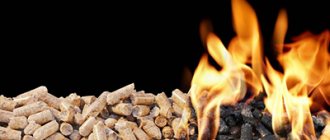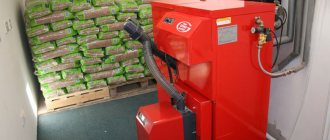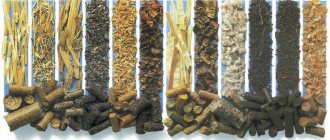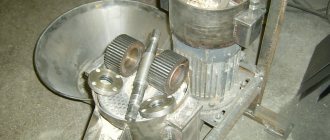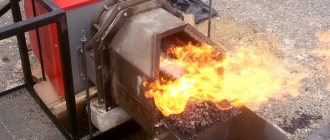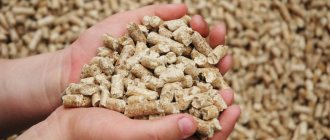The main disadvantage of straw as a fuel is its rapid combustion, due to which it does not have time to heat anything, and it is very difficult to load a boiler or furnace with a new batch of such fuel before the old one has burned out due to its extremely low density.
Therefore, the best solution is to press straw, with the help of which it is turned into briquettes of various shapes, which have a much higher density.
Straw as fuel: calorific value
The specific calorific value of any fuel is measured in various units, but the easiest way to do this is in kilowatts (kW) per 1 kg of weight, but you can use megajoules (MJ) or kilocalories (kCal).
We have compiled a table that includes the calorific value of various types of straw and those materials that are most often used for heating a house or cottage:
| Material | Calorific value | ||
| kcal | kW | MJ | |
| Fresh wheat straw | 3400 | 3,95 | 14,2 |
| Dry wheat straw | 3750 | 4,4 | 15,7 |
| Fresh flax straw | 3400 | 3,95 | 14,2 |
| Dry flax straw | 3805 | 4,4 | 16 |
| Fresh straw pellets/briquettes (humidity 30–40%) | 3500 | 4 | 14,65 |
| Straw pellets/briquettes after drying (humidity 10–15%) | 4000 | 4,65 | 16,7 |
| Fresh firewood (humidity 50–60%) | 1940 | 2,2 | 8,1 |
| Dry firewood (humidity 20%) | 3400 | 3,95 | 14,2 |
| Brown coal | 3100 | 3,6 | 13 |
| Black coal (stone) | 6450 | 7,5 | 27 |
| Dry chips (humidity 20–30%) | 2610 | 3 | 11 |
| Sawdust (humidity 20–40%) | 2100 | 2,4 | 8,8 |
| Pellets/briquettes from sawdust or wood chips | 4100 | 4,8 | 17,1 |
In terms of its calorific value, straw is on the same level as dried wood, so it is well suited for heating .
The only problem is that the uncompressed material takes up too much volume.
Therefore, to transform this material into a full-fledged fuel, it is necessary to somehow increase its density. However, there are heating stoves that can operate on uncompressed straw, but they are all very large in size and low in efficiency.
Benefits of hay pelletizing
Pellets are made from ordinary hay, which is dried, ground into flour and then fed into a pelleting machine.
Benefits of pellet hay:
1. Suitable for
feeding many types
of livestock, and also suitable for rabbits.
2. The product in pellets retains more useful substances
than in bulk, as research by scientists from the UK has proven. This food contains substances necessary for animals: molasses, fat, hydrol, bentonites.
3. The feed matches the digestion pattern of the livestock as the hard pellets are digested in the same way as natural feed. Moreover, they are absorbed much better
than mealy feed, which is difficult for cattle to grasp and chew.
4. The quality of feed is almost unaffected by humidity and temperature. The product does not freeze
at low temperatures and
does not cake
during long-term storage.
5. Animal feeders are not contaminated with food residues, since the granules crumble minimally. Using pelleted food keeps your food clean.
and sanitation in feeders without much effort. The use of hot steam during the granulation process prevents the proliferation of pathogenic microflora in the feed.
6. The product is convenient to transport
compared to loose feed, since the granules have a dense structure and a higher bulk density. Their flowability allows the use of any transport, and it is not necessary to pack it in containers.
7. Due to the compactness and heaviness of grass pellets, less feed is wasted
when distributed.
So, granulated hay is a promising type of feed for farm animals. Plant stem pellets can be used for other purposes. Thus, straw is used to produce pellets for heating premises and bedding for keeping animals.
What equipment is needed to produce it on an industrial scale?
DIY fuel briquettes
There are three main ways to make briquettes:
- baling;
- gluing;
- pressing.
Baling
Baling, as well as rolling into rolls, is carried out using special units standardly installed on combines, as well as in the form of trailed or mounted devices (hay balers).
Such devices can be made with your own hands, which is confirmed by the discussion of making briquettes on various forums and reports on them.
The only disadvantage of baling is that it is impossible to achieve a density comparable to at least dried wood, so the stove or boiler must be large enough , especially if you do not want to add fuel every hour.
If you make a baler from thick wood or metal, and create pressure not manually, but using a hydraulic or electric drive, you can achieve half or three-quarters of the density of dry wood, which will reduce the size of the heating device.
Regardless of the density of the bale, its strength directly depends on its size, so the larger it is, the more durable it will be .
This is due to the fact that each straw is not only crushed, but also intertwined with others, so the more of them intertwined, the stronger the bale or roll will be.
For the same reason, large rolls weighing several centners are the strongest. It is impossible to make bales the size of a brick in this way, and even of sufficient strength, so the method is applicable only for the production of large briquettes.
We have prepared links to the most interesting discussions and reports:
- fermer.ru.
- forum.fermeri.com.ua.
- www.ya-fermer.ru.
Gluing
This method does not greatly increase the density of compressed straw, but it allows you to make briquettes of any size, up to pellets with a diameter of several mm.
To make briquettes this way, you will need:
- any organic binder;
- grass chopper;
- soaking container;
- a press with molds coated with a substance that has zero adhesion to the selected binder.
To make fuel this way, you will need any organic glue or glue-like binder, such as :
- expired or damaged wallpaper glue;
- spoiled flour or starch;
- manure or droppings.
The latter material gives the best results, because excrement after drying not only has a high calorific value and also binds straw particles well to each other, but also does not form complex toxic substances after combustion.
You should not use PVA and other synthetic adhesives as a binder, because during combustion they form toxic and carcinogenic substances that pose a threat to humans.
Despite the fact that the smoke comes out into the chimney, it does not dissolve in the atmosphere, but gradually falls to the ground, so it first reaches the level of inhaled air, and then mixes with groundwater and forms toxic and carcinogenic solutions.
To make fuel this way, proceed as follows :
- Chop the straw; the articles Straw Cutter and DIY Straw Cutter will help you with this.
- Mix the chopped vegetation with a binder (the method of preparing the binder, as well as its quantity, depends on the type of substance, so the optimal proportions only come with experience).
- Load the required amount of mixture into the press dies and press them. In most cases, you have to make several loads; to avoid this, you need a large press stroke, that is, a large initial volume of the matrix. The normal density for such fuel is a quarter or half of the density of dry wood, that is, 200–400 kg/m3. If a higher density is required, you will have to use unshredded straw, which is much more difficult to work with. Another way is to press under higher pressure, but this will require maintaining pressure until at least the initial polymerization of the binder.
- Remove the compressed briquette from the matrix and dry to a moisture content of 20%.
- Store fuel only in dry, ventilated areas.
If the selected binder has high adhesion to the mold, in other words, if the glue sticks to it, then treat the surface of the mold and press matrix with silicone spray or other preparations that have zero adhesion to the selected binder.
Pressing
This method is the most complex, but at the same time the most effective, because the density of the finished product is comparable to the density of dried oak or hornbeam wood, and also has a high calorific value .
The basis of this method is one of the features of lignin, which turns into a liquid state at a pressure of 100–150 atm.
At this pressure, the straw becomes very hot, but due to the lack of oxygen, it does not oxidize, so instead of combustion, the lignin melts and glues neighboring straws together. This process occurs throughout the entire compressible volume of the straw, so after pressing it is a single, fairly strong mass .
It is quite difficult to make a press or extruder at home that not only creates the necessary pressure, but also has more or less decent productivity.
You can make a press from a powerful hydraulic jack, but to create a briquette 5 cm thick you will need a force of 3 tons, but if you make at least 10 briquettes at the same time, then the force should be at least 30 tons.
In addition, the press stroke must be at least 4 times the length of the finished briquette (more is better), and such a unit cannot be made small and mobile.
If you make a screw press with an internal diameter of 10 cm, then it must create a pressure of at least 10 tons, that is, you will need not only a 5-10 kW motor, but also a fairly durable worm gearbox capable of withstanding such a load. But even after getting all this, you will have to seriously invest in making the housing and the screw, and you will also need replaceable dies with holes of different diameters .
In addition, straw is suitable for pressing, the moisture content of which is in the range of 6–12%, that is, in addition to chopping it, it will also have to be dried using a vacuum or heat dryer. All this equipment consumes quite a lot of electricity, so it is impossible to use it at home.
We talked in more detail about such equipment and the general principles of organizing production in these articles:
- Sawdust briquettes.
- Equipment for processing wood waste.
- Sawdust recycling business.
Equipment for the production of pellets
Equipment for the production of pellets includes:
- crusher for grinding raw materials.
- Dryer;
- pellet press;
- cooling equipment for finished raw materials;
- packaging equipment.
Pellet production line
A fully assembled pellet production line will not be cheap. Its complete set includes drying drums, conveyors, scales, fans for blowing material, and hammer mills. The main role here is played, of course, by the pellet machine. You won’t be able to make it yourself, since you will need a milling machine to create the matrix. Pelleting equipment may vary in the quality of the pellets produced. Processing accuracy may vary from standards.
Homemade crusher
The production of pellets requires a crusher, which you can assemble with your own hands. If the raw material contains branches or other occurrences such as slabs, then additional equipment will be required to grind them. Of course, there are quite a few designs of such equipment. Some of them grind raw materials into not too large fractions.
Homemade crusher diagram
To make your own crushing machine, you will need one electric motor, quite powerful, and several circular saws. Such a machine will be a good helper to start your own pellet production. They are mounted on the same shaft. They are fixed in such a way that each subsequent saw tooth moves relative to the previous one. A pulley and a pair of bearings on the sides are placed on this shaft. The shaft is installed on the frame and fixed there. It should be borne in mind that the engine must have sufficient power to be able to crush branches and boards into the required sawdust size. The performance of such a unit is not the highest.
Sawdust dryer
Making pellets involves drying the raw materials. To prevent pellets from crumbling immediately at the exit from the pressing machine, it is necessary that the sawdust be of the required moisture content. In large production this is done in special chambers. At home, some craftsmen make drum dryers, since this design is the simplest.
Homemade sawdust dryer
Iron barrels are welded to each other. Next they are placed on the frame. Blades are welded to the inner walls, which interfere with the raw material during drying. Hot air is supplied from one side of the improvised drum, and this air leaves from the other. The drum rotates using an electric motor through gearboxes. The source of hot air can be a conventional heat gun.
You should know that this technological process is the longest and most energy-consuming. Therefore, expenses may exceed income.
What is better for heating?
Bale heating requires very large boilers.
In addition, this process cannot be automated, that is, at least once a day you will have to approach the boiler and put a new portion of flammable material into it.
In addition, carrying fairly large bales is not very convenient, so heating with straw in briquettes, even in stoves and boilers without automatic feeding, is much more convenient, because the volume of fuel required to release the same amount of heat is many times smaller.
The situation with pellets is somewhat different, because due to their small size they are difficult to load into conventional boilers or stoves, but they are well suited for long-burning heating devices with vertical fuel loading. Like briquettes, they take up much less space than bales, which means the same volume is enough either for stronger heating or for longer operation, allowing for less frequent loading of fuel.
However, the strongest differences appear if a solid fuel heating device with automatic loading of combustible material is installed in the house, because neither straw nor firewood are suitable for such devices.
But briquettes, due to their identical shape, and pellets, due to their small size, are well suited for such devices, so after putting fuel in the bunker, you don’t have to worry about fuel for several days .
Is making briquettes justified?
The average cost of non-automatic, that is, requiring constant attention, equipment for the production of briquettes or pellets, including a dryer, is one million rubles, and installing a fully automated line will require at least 2 million rubles .
In addition, even a fully automated line still requires human participation, because it is necessary to load the raw materials into bins, then periodically check the process and put the finished product aside.
All this says one thing - making briquettes or pellets for heating your home does not make any sense, unless you have a couple of extra million rubles that can be spent on such entertainment.
Hay pelleting equipment
The hay granulation technology is similar to the algorithm for producing fuel pellets, but it includes one more element - a chipper for straw rolls.
The main equipment for hay pelletizing line is listed below.
1. Straw bale chopper
A device with a large round hopper, where the straw roll is crushed when the rotor with beaters rotates. The chopper chops hay rolls into chaff, which is then re-shredded in a rotary crusher.
2. Impact crusher with pneumatic system
The impact crusher is configured specifically for crushing stem crops. It ensures that the straws are crushed to a flour fraction of no more than 5 mm in length. The pneumatic conveying system sucks up the cut grass through the intake hose and delivers the resulting grass meal through the discharge hose to the mixer.
3. Feed mixer or hopper agitator
If you want to produce hay-based feed according to a recipe, you need a feed mixer - a hopper with an additive input auger that ensures high-quality mixing of all the ingredients of the feed mixture. If the breeder’s goal is simply to press hay and straw, then for this task it is better to choose a bunker with a raw material agitator. The mixer and agitator hopper evenly dose the raw material into the receiving hopper of the OGM granulator.
4. Hay granulator
The OGM granulator is used in industrial hay pelleting lines. This ring die press is designed to produce at least 0.5 tons of pellets per hour. Raw materials from the receiving hopper enter a screw dispenser, which moves the mass further to the mixer. Once there, the raw material is doused with steam and mixed using a paddle mixer. It moves towards the entrance to the pressing chamber. When the steamed herbal mass falls into the chamber, it is clamped in a wedge-shaped space between the press rollers and the rapidly rotating ring die. The raw material passes under pressure through the holes of the matrix, and hot granules come out from the outside of the matrix.
5. Scraper conveyor and cooling column
Since granulation takes place at high temperatures, the granules require forced cooling to maintain a dense structure. They are sent to a cooling column, where the product is screened and non-granulated particles fall down through the sieve. Typically, the granulator and cooler are connected by a scraper conveyor onto which the granules are poured.
6. Packing
After cooling, the product, again, is sent to the packaging unit using a conveyor. This could be a filling dispenser that pours pellets into bags installed on a weighing platform. The product can also be packaged in big bags, under which a special frame is mounted.
7. Line and granulator control panel
The operation of the entire line is started and monitored from the control panel. The device monitors the state of the entire system, the occurrence of imbalances and stops operation in case of malfunctions. A separate control panel is used for the OGM granulator.
All of the listed equipment is manufactured at the ALB Group plant using world-class components.
Business profitability
The finished product will have to compete with the same briquettes or pellets made from sunflower husks, and their average cost is 6 rubles per 1 kg.
If, taking into account all expenses, you can reduce the price to at least four rubles, then your product will successfully compete with briquettes or husk pellets, because wholesale prices for this fuel average 5 rubles per 1 kg.
You can achieve such a cost price only if you get the straw for free, and you don’t have to transport it far from the place of receipt to the place of processing, and electricity is supplied to you at a low tariff.
In addition, to cover all costs and obtain any noticeable profit, you need an established distribution channel capable of receiving tens of tons of this fuel daily.
If there is no such channel, then there is no need to talk about any profit, because even short-term storage of finished fuel involves its delivery to a specially equipped room with forced ventilation and a humidity level of 5–10%. This means that you will have to spend money on the construction and maintenance of such a premises, which reduces the already low income.
Equipment for the production of briquettes from sunflower seeds husks
The technology for manufacturing fuel briquettes from biomass (which includes sunflower husks, rice, buckwheat, etc.) is as follows:
- The raw materials are washed and dried.
- Grind.
- They are compressed.
- Cool.
- Packing.
Equipment is selected accordingly. You will need a dryer and a crusher (hammer or shredder), but most importantly - a press (piston, extrusion or screw). Facilities for transporting raw materials and finished products to the shop floor, cooling facilities and packaging equipment may also be required.
The main equipment for the production of any briquettes is a press
